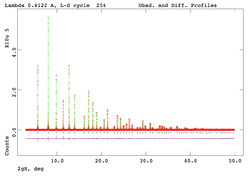GSAS Profile Terms
Peaks Profile terms for Rietveld Analysis
Most Rietveld refinement programs use a pseudo-Voigt term combining Gaussian and Lorentzian peak shapes (plus other correction terms). In general, the X-ray source can be described by a Gaussian function, while sample effects are described by Lorentzian terms.
For the synchrotron powder XRD data from 11-BM, the instrumental resolution is well described by Gaussian terms. Sample effects, such as size and microstrain broadening (i.e. local variations in the lattice parameters) are usually fit best by Lorentzian terms. Gaussian sample size broadening is *rarely* observed; this re- quires a very tight monodisperse distribution, which is rarely encountered in powder specimens but is sometimes seen in polycrystalline solid specimens such as pieces of metal.
Please consult other references (such as the GSAS manual) or Powder Diffraction Crystallography Video lectures for details on Rietveld profile functions.
11-BM Profile Fitting
Representative LaB6 data for 11-BM (high resolution powder XRD) can be downloaded from the 11-BM webpage here (pick your format):
Full details for the dataset collected in Feb. 2010 are as follows:
precise wavelength = 0.412235 A data was collected on a spinning 0.8 mm diameter capillary of LaB6 660a The NIST LaB6 660a SRM certificate lattice value = 4.15691(1) A. The estimated muR (X-ray absorption) is ~ 1.0 collection temp: 295 K 2theta range: 0.5 deg - 50.0 deg step size: 0.001 deg
For the 11-BM dataset collected on LaB6 in Feb. 2010, the following parameters provide a good Rietveld fit using GSAS/EXPGUI:
space group: Pm-3m a = 4.156917(1) zero shift: -0.00029 deg 2theta La @ 0, 0, 0 (Ui/Ue*100 = 0.62) B @ 0.1984(1), 1/2, 1/2 (Ui/Ue*100 = 0.29) GSAS Profile type 4: (non-listed terms = 0.0) Coeff. : GU GV GW LX S/L H/L Value : 2.552E+00 -5.439E-01 5.990E-02 2.790E-01 1.2E-03 1.2E-03 background = 4-term Shifted Chebyschev (type #1)
Gives the following Rietveld fit statistics
wRp = 6.45%, Rp = 4.86%, CHI**2 = 3.349 (for 14 variables)
Image of fit plot is shown below (click to enlarge):
Conversion of pseudo-Voigt function terms
11-BM provides users with instrument profiles terms for GSAS. Convert these values to Fullprof profile terms using the formulas below.
For more info see: "Typical values of Rietveld instrument profile coefficients" Kaduk J, Reid J. Powder Diffraction (2011) vol. 26 pp. 88
Gaussian Parameters
GSAS Term <=> Fullprof Term : (description) GU = 1803.4 * U : (instrumental term, ~ tan^2 of theta) GV = 1803.4 * V : (instrumental term, ~ tan of theta) GW = 1803.4 * W : (instrumental term, ~ constant with theta) GP = 1803.4 * IG : (size broadening) note: 1083.4 => centidegrees squared divided by 8*ln(2)
Lorentzian Parameters
GSAS Term <=> Fullprof Term : (description) LX = 100 * Y : (size broadening) LY = 100 * X : (microstrain) note: 100 => degrees to centidegrees
Finger-Cox-Jephcoat asymmetry parameters
GSAS S/L = Fullprof S_L GSAS H/L = Fullprof D_L Note: terms are equivalent
GSAS Refinement Hints
Profile type #4 anisotropy Sxxx terms
Q: What is the "best" order for incorporating GSAS profile 4 anisotropy Sxxx terms into a refinement? A: from Robert Von Dreele (July 28, 2011) "Usually, I do the S4xx ones first & then the others. The thing is fairly stable after that. Do do all of them at once in any case in the end. The S4xx must be > 0 but the rest can be any sign. If you want a quick way of seeing the shape, run mustrplot (spelling?) in GSAS; you'll need gnuplot to see the plot. For monoclinics, it might look like two beans back-to-back." -Bob
